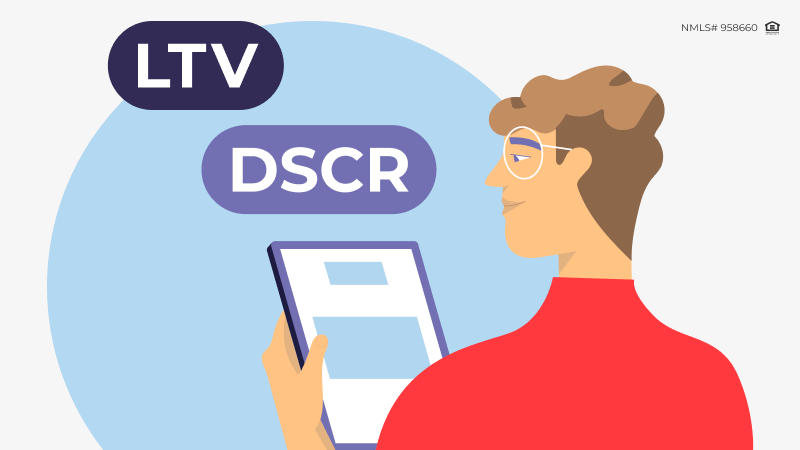
Real estate investment is not a one-size-fits-all endeavor. It’s a complex world with a multitude of factors to consider. When it comes to financing your real estate ventures, two essential metrics stand out: Debt Service Coverage Ratio (DSCR) and Loan-to-Value (LTV) ratio. Each has its unique role and importance in the realm of real estate financing. In this comprehensive guide, we will dive deep into the differences between DSCR and LTV, explore scenarios when each metric is more relevant, and provide insights to help investors choose the right financing option based on their investment goals.
Understanding DSCR and LTV: A Primer
Before we delve into the comparison, let’s get acquainted with these two critical metrics:
Debt Service Coverage Ratio (DSCR):
DSCR is a financial metric that assesses a property’s ability to cover its debt obligations with its rental income. It’s calculated by dividing the property’s net operating income (NOI) by its total debt service (loan payments). DSCR provides insight into whether the property generates enough income to service its debt, with a higher DSCR indicating stronger cash flow and a lower risk of default.
Loan-to-Value (LTV) Ratio:
LTV ratio represents the proportion of a property’s value that is financed through a loan. It’s calculated by dividing the loan amount by the property’s appraised value. LTV is a risk assessment metric, with a lower LTV indicating a smaller loan amount in relation to the property’s value, thus reducing the lender’s risk.
Now, let’s dive into the comparison.
Comparing DSCR and LTV: Relevance and Applications
DSCR’s Significance:
- Cash Flow Assessment: DSCR is particularly relevant in scenarios where cash flow is a primary consideration. It helps investors and lenders assess the sustainability of loan repayment based on the property’s income-generating capacity. This metric is especially significant for properties where rental income forms the lifeblood of the investment.
- Commercial Real Estate: DSCR plays a critical role in commercial real estate transactions. Commercial properties often rely on stable cash flows from tenants to meet their debt obligations. Investors and lenders scrutinize DSCR to ensure that rental income is sufficient to cover loan payments.
- Residential Rentals: While DSCR is more commonly associated with commercial properties, it has gained traction in residential real estate investments, particularly for multi-unit properties. Investors can use DSCR to evaluate the potential income-generating capacity of a residential property and assess its viability as an income-producing asset.
- Income-Driven Objectives: If your investment objectives revolve around generating a steady stream of income, DSCR should be a primary consideration. A high DSCR indicates that the property has a strong cash flow, making it well-suited for income-focused investors.
When to Prioritize DSCR:
- Investing in Rental Properties: If your goal is to generate consistent rental income, prioritizing DSCR helps ensure that your property’s cash flow can cover your loan payments.
- Commercial Real Estate: Commercial properties often rely on stable cash flow from tenants, making DSCR an essential metric for lenders evaluating loan applications.
- Cash Flow Emphasis: If you value a steady stream of income from your investment, focusing on DSCR aligns with your income-driven objectives.
LTV’s Importance:
- Risk Assessment: LTV, on the other hand, focuses on the risk profile of the investment. It’s a measure of the equity cushion in the property. A lower LTV indicates a higher amount of equity invested by the buyer, which can provide a safety net against property value fluctuations or market downturns.
- Property Appreciation: LTV is particularly important when considering property appreciation potential. A lower LTV means you have a greater ownership stake in the property, and as it appreciates in value, you stand to gain more in terms of equity.
- Risk Mitigation: LTV is a valuable metric when you want to mitigate risk. A lower LTV reduces the lender’s exposure and provides a buffer against potential losses if the property’s value declines.
- Long-Term Wealth Building: If your primary goal is to build long-term wealth through property ownership, focusing on LTV can be beneficial. It allows you to accumulate equity in the property over time, which can serve as a valuable asset.
When to Prioritize LTV:
- Risk Mitigation: If your primary concern is minimizing risk and preserving equity, a lower LTV can provide a safety net against potential property value declines.
- Property Appreciation: If you’re banking on property value appreciation as a primary return on investment, a lower LTV ensures that you have a greater ownership stake in the potential profit.
- Market Volatility Concerns: When market conditions are uncertain or volatile, a lower LTV reduces the impact of market fluctuations on your equity.
Balancing Both Metrics: An Optimal Approach
While DSCR and LTV have distinct roles, they are not mutually exclusive. In fact, a balanced approach that considers both metrics can provide a comprehensive view of an investment’s financial health and risk exposure. A high DSCR coupled with a conservative LTV ratio signifies strong cash flow and lower risk, making the investment more attractive to both investors and lenders.
Example of Balancing DSCR and LTV:
Imagine you’re considering two investment properties:
Property A:
- DSCR: 2.0
- LTV: 70%
Property B:
- DSCR: 1.2
- LTV: 50%
Property A has a higher DSCR, indicating strong cash flow, but a relatively higher LTV, suggesting a lower equity cushion. Property B, on the other hand, has a lower DSCR, implying weaker cash flow, but a lower LTV, indicating a higher equity stake.
In this scenario, an investor might opt for Property B if their primary goal is long-term wealth building and risk mitigation. The lower LTV provides a more substantial equity buffer against market fluctuations. Conversely, an investor seeking immediate cash flow might favor Property A due to its stronger DSCR.
Conclusion: Informed Decision-Making for Successful Investments
Understanding the differences between DSCR and LTV empowers investors to tailor their financing choices to their unique investment goals. Prioritizing one metric over the other depends on the emphasis placed on cash flow, risk mitigation, property appreciation, and market conditions. Ultimately, the synergy between DSCR and LTV aids investors in making well-informed decisions that align with their financial aspirations and pave the way for successful real estate ventures.
In an ever-evolving real estate landscape, where each investment is unique, investors can find success by mastering the art of balancing these two critical metrics. By striking the right balance between DSCR and LTV, investors can optimize their financing options, mitigate risk, and maximize the potential for long-term wealth creation through real estate investments. Remember that while each metric provides valuable insights on its own, it’s the harmonious combination of both that leads to well-rounded and prosperous real estate ventures.
As a mortgage broker, your clients rely on your expertise to find them the best deals. Our Quick Pricer tool can be an invaluable asset in your quest to secure the most advantageous mortgage rates. Be sure to explore our Programs section for additional resources tailored to your needs. If you have specific scenarios in mind, don’t hesitate to request them; we’re here to assist you. And if you’re interested in joining forces to provide even more value to your clients, consider becoming a partner with us. Together, we can empower individuals and families to achieve their dreams of homeownership.


